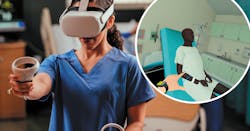The University of Rochester School of Nursing is among several nursing schools that have been piloting virtual reality-based learning solutions to allow students to encounter real-life challenges such as prioritizing care among multiple patients and the demands of practice.
In a recent interview with Healthcare Innovation, University of Rochester nursing educators discussed their pilot of Wolters Kluwer Health’s vrClinicals for Nursing. Nursing school testers of the solution included Villanova University, Indiana University, University of Rochester, University of Massachusetts Boston, University of Central Florida, and University of Virginia, noted Julie Stegman, vice president, nursing segment, health learning, research & practice at Wolters Kluwer Health.
“To create practice-ready nurses who are competent to not only pass the licensure but feel clinically ready and competent, we have to give them as many clinical practice experiences as possible,” Stegman added. “We had started that in creating simulations with our partner Laerdal Medical, as well as the National League for Nursing and that's been on the market for the last 10 years or so. But because it's computer-based, it doesn't necessarily provide that immersive real-life experience. Virtual reality as a medium really takes that clinical experience to the next level. You're hearing codes, you're hearing distractions, and also because of the medium itself, we can introduce multiple patients.”
The University of Rochester School of Nursing has two VR classrooms with 10 available headsets to encourage greater practice time and hands-on experience for nursing students. The new classrooms opening in spring 2022 as part of a 26,000-square-foot expansion designed to enhance experiential learning for nursing students.
“When you're taking on that multi-patient load in the clinical setting, you have to be able to prioritize clinical care and delegate clinical care when appropriate,” said Kaitlyn Burke, M.S., R.N., assistant professor of clinical nursing at the University of Rochester. “That is a skill that you have to learn and it's ideal if you can learn it in a safer environment like in the metaverse where nobody's life is in jeopardy. I think that's one of the bigger things about VR is that it can build harder skills like that in a very safe space versus just trying to learn it on the job.”
The VR simulation records the student’s actions. Part of the value of simulated learning is the post-simulation practice, which is reflection and debriefing, so it's giving you a detailed feedback report, Burke explained. “It's making suggestions in terms of how you could have prioritized differently, how you could have done care differently, and then it's giving you references for best practices.”
The National Council of State Boards of Nursing has completely changed the licensure exam, so that they're actually testing on clinical judgment and critical thinking, added Tara Serwetnyk, Ed.D., R.N., director of academic innovation and an associate professor of clinical nursing. “The literature shows that in the past, nursing students have not always been able to apply what they're learning in the classroom setting to the clinical setting. This is one strategy that we have used to bridge that gap and provide students with more clinical experiences while they're students to help prevent future errors when they are actual nurses in the care setting. Activities such as VR and simulation in general provide some consistency for us as educators to assess them with their competencies, and we're looking at that shift to competency-based education. We're looking at how well they've obtained those competencies and we’re able to assess them in a meaningful and equitable way.”
Incorporating VR into the curriculum is a work in progress, Serwetnyk added. “If there's a module on a certain concept and we see these learning objectives of this virtual simulation, we'll tie that in with the learning objectives or align that with the learning objectives of the module. One of the things that I like about vrClinicals is that it is versatile. In an ideal world, we would be able to customize it, but in reality, I don't think that's feasible because we don't have the bandwidth. But having resources that are versatile is really helpful. For instance, in the vrClinicals product, they have two-, three- and four-patient scenarios. You could potentially scaffold that across the program. You're paying for one resource, but you're able to implement it throughout the whole curriculum.”
Stegman said that Wolters Kluwer had 12 schools of nursing participating in the beta program as well as the National League for Nursing. ‘We did LEAN product development with this with design sprints at the very beginning,” she said. “We would design concepts we had been talking to customers about, and then through the beta process, people like Kaitlyn and Tara have been essential because this is a new modality. I think it's pretty new in nursing schools. It's new for all of us. You've got hardware, you've got logistics, you've got a lot of other things to think about besides just the user experience and the content or the scenarios that we're offering. So it was really an invaluable process. Now we are in market, we're actively looking for customers in terms of adoption and integration into nursing programs.
Serwetnyk said to prepare for the change in licensure exams, they started the transition in terms of the way they teach back in 2019 to a more active and collaborative approach. Part of that involves bringing clinical situations into the classroom as much as possible. “Students might be working through a virtual simulation as part of their class or in a small group or working through evolving case studies with digital technology in the classroom. We have skills trainers that they're using in multiple different environments, and along with that, they're documenting the skills that they're actually completing using DocuCare [an academic EHR training solution from Lippincott]. So they're building step by step to what you would do in the clinical setting.”
Serwetnyk said one thing they would like to see in the future is other specialty areas such as pediatric nursing. Stegman said they definitely have a roadmap in terms of extending into other areas and anticipate publishing more scenarios.


